Let’s start with a disclaimer:
This blog post, like my last two, is based on personal reminiscences. I’m telling my little stories while my aging and cracking memories still have enough integrity that I can pretend there’s an element of truth to them.
Here I’m going to focus on my participation in the New-York-City-area table-top role-playing fan community in the 70s and 80s. Because I’m usually the protagonist of my own stories, this may give you the impression that I made important contributions to fandom.
That would definitely be a false impression. I was a minor rivulet in the torrent of fandom’s activities, emotions, feuds, interactions, loves, and rivalries.
Though I may not mention him often enough, the person I’d like you to remember is the late Robert Sacks. He was known for his bow ties, his constant energy, for being easily infuriated, and for being easily infuriating. He added to any project in which he was involved, though perhaps it could be debated exactly what he added.
In turn, Robert was only a part of the complex interactions among the gaming and SF fan communities in the NY area. However, he was a significant part, providing organizational effort to many groups that did not publicize his name.
For a long time, he and I were antagonists. Then we were protagonists. Then we were merely agonists, as we watched the communities in which we’d invested so much energy slowly absorbed into the rapacious maw of the Internet.
Any history of New York genre fandom in the 70s and 80s should include him.
Why did I open the trunks?
In my last post, I said that I opened some old trunks that had been sitting in my closet for decades.
The reason why I opened the trunks is that I became curious after I received a query from H. Tucker Cobey, who writes a blog for Epic Table Games. Cobey was doing research on the origin of the word “munchkin” in the sense of referring to young raucous gamers, as in the Munchkin series published by Steve Jackson Games. Cobey had traced a potential source to the particular gaming community of which I was a part in the 70s and 80s.
In deference to Cobey, I am not going to discuss what was discovered through me. I’ll leave that to the article in the Epic Table Games blog.
Instead, I’m going to describe the flood of memories, both good and bad, that I recalled as I went through that second trunk.
What is an APA?
In my last post, I promised I would answer this question.
“APA” is an acronym for “Amateur Press Association.” It basically refers to a group of volunteers who self-publish among themselves to create an amateur magazine. If I believe the Wikipedia article, APAs were started in the 19th century, and (to my surprise) still exist today, though they are no longer the primary means of communication among fans.
To get a better idea of how an APA works, let’s start with a visual aid:
What was in the trunk?
This:

To you, they probably look like meaningless piles of paper.
And that’s what they are! Quick, click on a link and get out while you still can!
Too late! Click faster next time!
To me, those piles of paper are the APAs to which I contributed in the 70s, 80s, and early 90s. They’re a record of the opinions, dreams, and talents of many people who wanted to share their views or their art related to role-playing games, science fiction, fantasy, comics, computers, and conventions. They’re a record of my foolishness, folly, prejudices, and assumptions; they also represent the best of my talent and energy that I could muster at the time.
Going through that pile is roughly as interesting as having a grandparent sit with you and have you look at the pictures in their photo album. It might be dull. Or it might be that Grandpa has some wisdom to share. Make some room on the sofa for good ol’ Bill and we’ll see which is the case here.
Making an APA
Different APAs have different methods of gathering contributions and assembling issues. This is how it was done in the APAs in which I was involved.
The head organizer of the APA would announce the date of a “collation”; e.g., “We are collating issue #78 of Pandemonium on December 3, 1983. The copy count is 50.” Everyone who wanted to contribute to that issue would arrange to have 50 copies of their contribution made and bring them to that collation.
APAs often had an art director. It would be their responsibility to accept contributions for cover art. If they thought the artwork was suitable for a front or back cover, they’d add the logo (if it wasn’t already present) and the issue number and date, then make the copies.
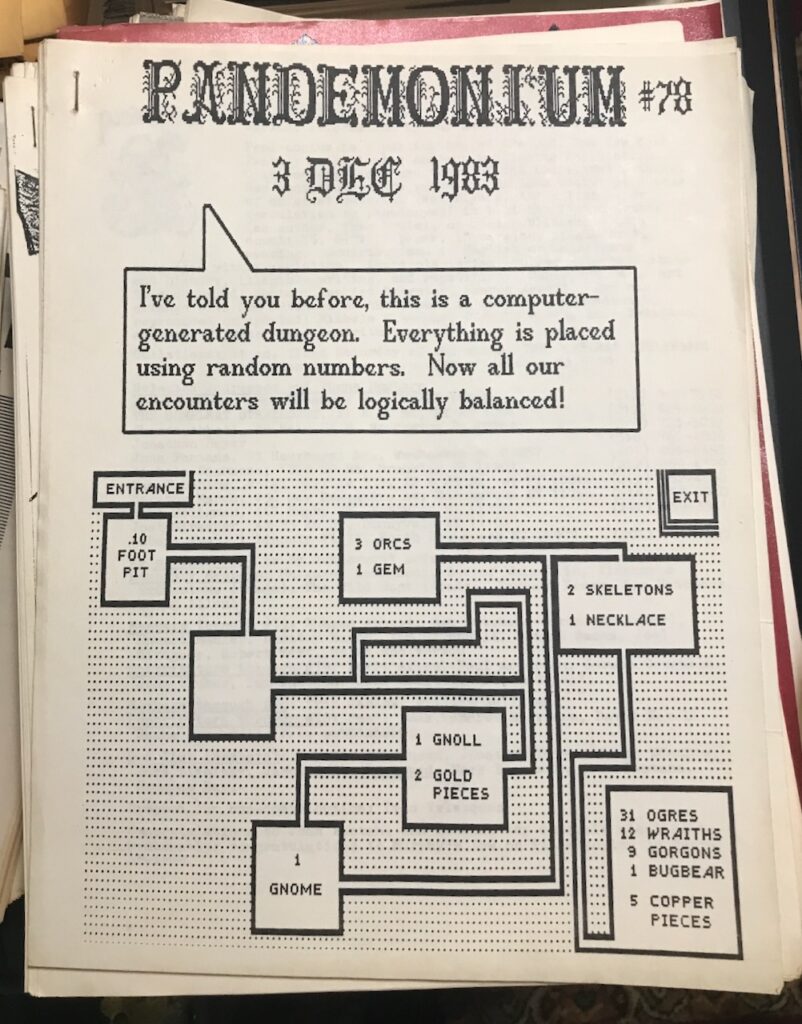
Consider what the contributors had to do. Each contributor was responsible for making enough copies of their article to be included in the collation. Most folks typed their contributors on a typewriter. After a point, many of them had computers (I did), but that only helped to format the article. Laser printers did not yet exist when I first got into the hobby, and dot-matrix printers (Inkjet? What’s that?) could not churn out 50 copies of even a single page, much less the multi-page contributions typical of an article.
In the early years of APAs, people used mimeograph machines, which involved typing your article into thin sheets that resembled wax. It was an unforgiving medium; if you make a typographical error you could either X it out (which looked bad) or retype the entire page from scratch and hope you didn’t make another error.
Edit added over a year later: When I typed the above paragraph, I’d completely forgotten about correction fluid. If you’re reading decades-old fanfic and you across the name “Corflu”, it refers to that.
By the 70s and 80s, we mostly used copiers. Such machines were out of reach for individuals. Many contributors went to copy shops and paid to have them duplicated. Others stayed late at work to make copies on the office copier. (This is something that I never, never, never, ever, rarely, occasionally, often did.)
At a typical collation, I walked into the collating room with copies of my article. (Woe betide the contributor who did not make enough copies for the copy count!) Someone was appointed to be a collation coordinator. They laid out all the individual article pages (or perhaps piles of pre-collated individual articles, if the contributor had arranged that with their copy shop) along the edges of a large table.
The collation coordinator would sit us around the table, and tell each of us which pages we’d collate. I’d collate my pile into sub-sections. Eventually the person on my left would hand me a pile consisting of all the pages of a single issue that had been collated thus far. I added my sub-section to the bottom, and hand that to the person on my right.
Eventually completed issues would reach the end of collator line-up. The last person in line would staple the issue. It was a task that required forearm strength and a good-quality stapler.
The head organizer would hand out copies to everyone who contributed, whose artwork had been accepted, who helped to collate, or (rarely) paid for the privilege of receiving an issue.
APA-DuD

There were quite a few APAs coming out of NY fandom. The one I connected with was called “APA-DuD”, which focused on role-playing games. (There were many APAs in the area on other genre topics, such as SF, fantasy, comics, etc.)
“Dud” was a typical slang word tossed about in NY-area fandom in those days (and perhaps in other geographic areas; I can only talk about what I saw). It was a general low-level insult; e.g., “You think a Beholder has nine eyes? You’re a dud!”
In the case of APA-DuD, I think the name was an attempt to be self-deprecating and an (ultimately unsuccessful) attempt to tamp down on the rampaging egos of contributors at the time. It might also have been a slangy reference to Dungeons & Dragons = D&D = DnD = DuD = Dungeons und Dragons.
At the time I first contributed to APA-DuD, I was already a contributor to two other APAs: Alarums & Excursions (published in Los Angeles) and The Wild Hunt (published in Boston). To be blunt, I was a total dick back then, and it showed in my writing. I sincerely hope that those old issues of A&E and TWH have been destroyed in a warehouse fire or something like that; even better, if that fire just burned my articles but left others’ well-written and thoughtful articles in place.
I guarantee you: There’s nothing I wrote in other APAs that’s worth seeking out. It was in the pages of APA-DuD and Pandemonium that I began to recover. It took a few years, though.
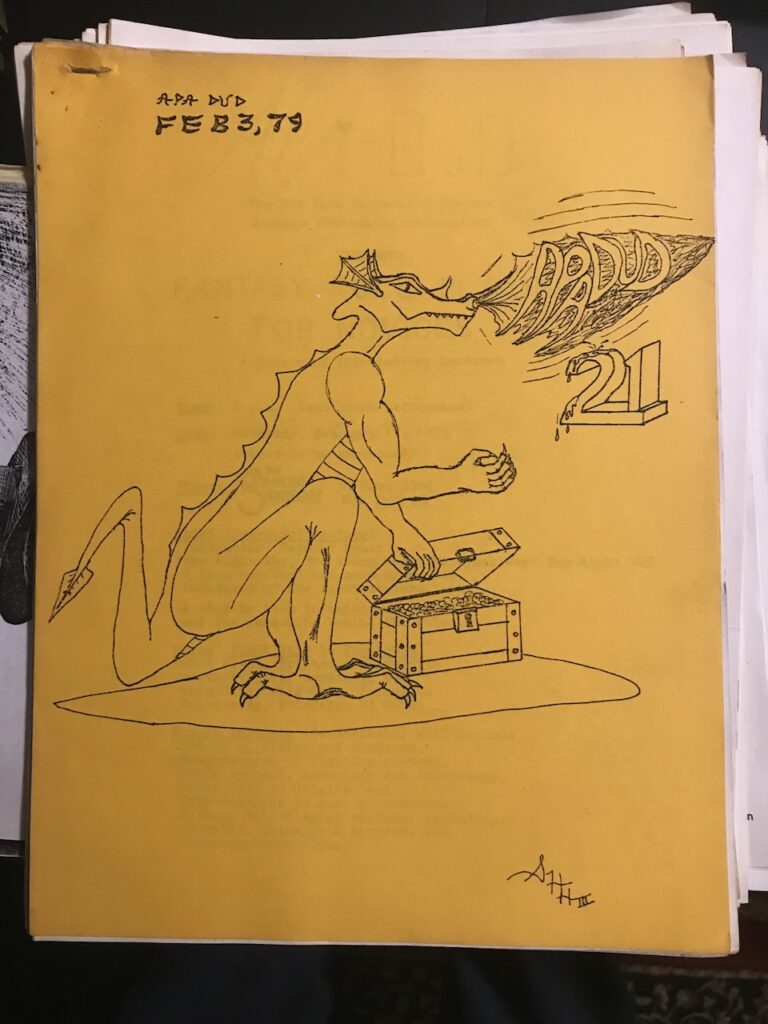
I have no memory of how and why I was convinced to start contributing to a third APA. It might very well have been that my behavior in the other APAs had riled up the other contributors to the point that I felt that I needed a new place to rant.
Politics
Every APA-DuD collation was tightly disciplined. The contributors and collators all arrived on time. There were never any arguments or disputes. The collation process ran smoothly. Everyone maintained a level of respect, quiet, and dignity.
Also, monkeys flew out of my butt.
By that, you may conclude that our collations tended to be chaotic affairs. It’s a wonder that we managed to get any issues out at all.
Robert Sacks was the elected head organizer of APA-DuD. His formal title was “Internal Secretary” (abbreviated “Insect”) to keep him humble. He did his best to reign in the chaos, but his leverage was limited. It consisted of either not giving someone an issue or banning them from collations, both of which were almost unenforceable. He was bound (by his own intention) by the APA’s Constitution.
Other APAs typically did not not require a Constitution. That may give you some idea of what NY fandom was like back then.
Since I’m trying to be honest, Robert’s personality did not lend itself to easing diplomatic tensions. He was an exemplar of many of the negative tendencies which permeate NYC SF fandom to this day. He tended to gather other exemplars around him as they followed his example. But do not conclude that just because someone was opinionated and found it difficult to work with others meant that they were automatically a friend of everyone else who behaved the same way.
Picture the United Nations, but without the diplomacy.
I won’t attempt to rehash the disagreements I had with Robert (and many others!) during that time, nor to rationalize my behavior. For one thing, I don’t remember these issues anymore. What little I recall seems petty and unimportant now.
One note of my stupidity: I happened to glance through a copy of APA-DuD as I was preparing this blog post, and saw that one time I ran for Insect against Robert Sacks. I thank the Great and Powerful Atheismo that I lost.
Munchkins
The APA-DuD collations were held once a month in the back room of The Compleat Strategist, a game store located one block away from the Empire State Building. At that time, the Strategist made that room available to gamers on weekends. It was mostly used by tabletop miniature wargamers. The large table needed to set up their battlefields was also ideal for collating APA-DuD once a month.
After a collation, groups of us would form to play RPGs (mostly D&D, though I occasionally ran Argothald) in various parts of the room, or leave to other nearby locations to play games.
In addition to the regular collators and contributors, the collations seemed to attract many young people (age 10 or younger). They would show up because the meeting space was convenient, and it was the only time that the back room at the Strategist was available for RPGs. They tended to be loud and raucous (or at least louder than us supposedly-more-mature types).
They also seemed uninterested in telling stories via RPGs or developing characters. They wanted to slay the monsters and collect the treasure. They didn’t seem to have much formal understanding of the D&D rules. It was mostly about the handing out of experience points, gathering their +10 vorpal blades, and boasting of their 20th-level Paladins. Or so it seemed to us at the time.
Note that the highly-successful video-game franchise Diablo is based on exactly that. So much for our predictive powers and judgemental attitudes!
I don’t recall who first started using the word “munchkin” as insult for those young gamers. The term meant someone who “was small in mind and years.” From a perspective of four decades later, the term seems quite prejudicial now.
I’m not sure if the word originated with the APA-DuD group. I also don’t know if there’s a chain that links our use of the word in 1980s to the name Steve Jackson gave to his first Munchkin card game two decades years later. When I look at the Munchkin cards, I see descriptions of the behavior we attributed to those young gamers (e.g., “Bribe the GM; gain one level”). But kids are kids, and the use of the term may be a coincidence.
See H. Tucker Cobey‘s blog for more.
We paid the price for our prejudice. In later years, contributions to the APA fell, as people went on to other things. We tried to recruit new contributors, only to learn that the “munchkins” of yesteryear were not interesting in participating in a group who’d alienated them before.
Pandemonium
One of the issues that I championed in the trivial APA-DuD feuds was the name of the APA. “APA-DuD” seemed amateurish. I argued (as did others) that if we wanted more and better-quality contributors, we should choose a more dignified name.
We had a naming contest. I vaguely recall that I did a poor job of managing it. In the end, we selected the name “Pandemonium.” The name literally means “demons running wild,” which was an apt description of us, though we hoped that the joke would be sufficiently obscure to outsiders. I liked it because I’d just read The Divine Comedy, and knew that Pandemonium was the name of the main city of Hell; that seemed appropriate in an fantasy role-playing game context.
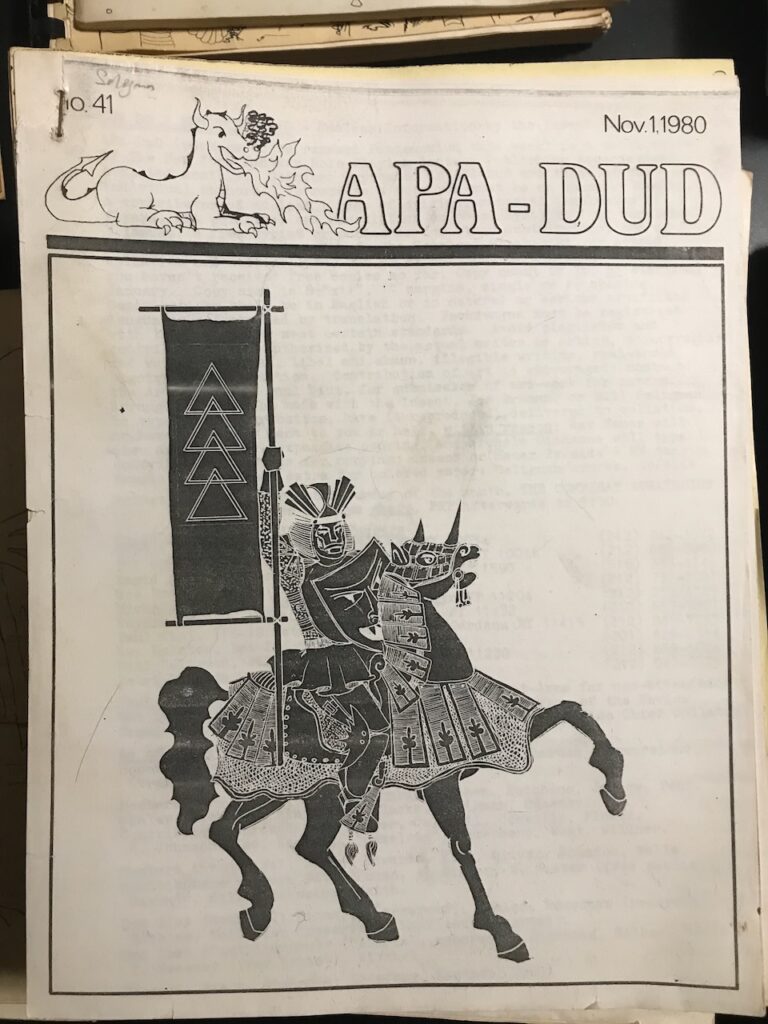
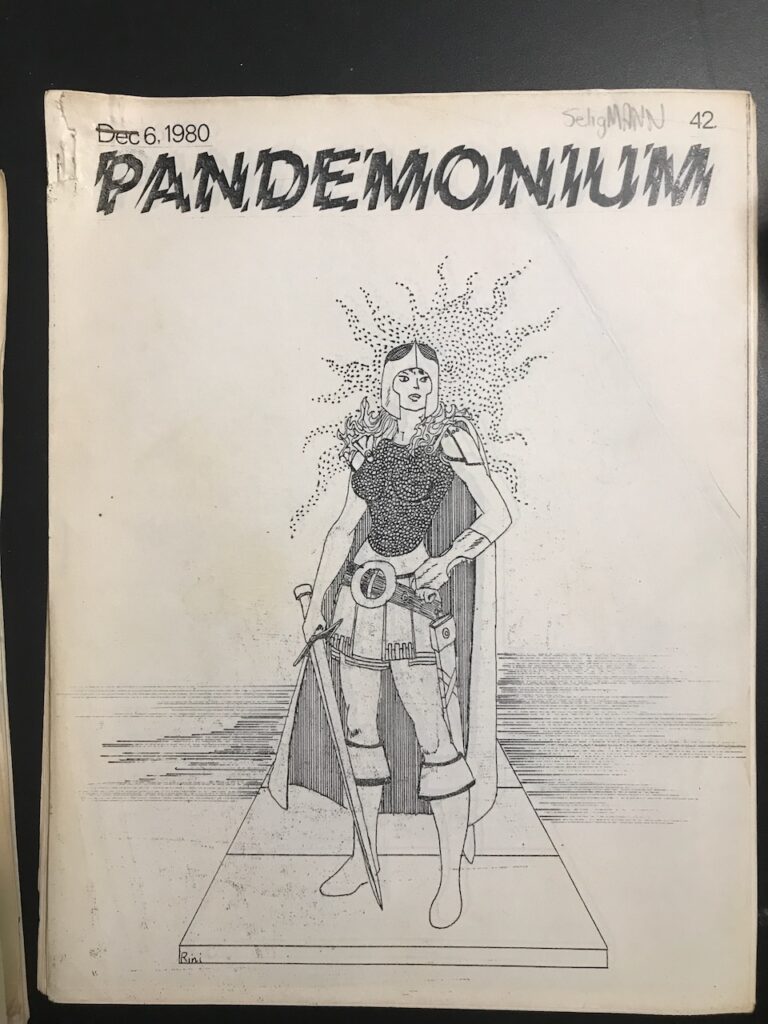

The name change turned out to be a good idea. My memory on this is dim, but I think it represent a “sea change” in the APA. I was still a fool (contributing stupid pretend-anonymous articles), but I gradually stopped expressing the foolishness in the pages of Pandemonium. Other contributors seemed to ease off a bit as well.
Pandemonium #75 was, in my opinion, our best issue. We had thicker issues both before and after. But it seemed to me that everyone put their best foot forward for this particular issue. It was the only one for which we had a color cover.
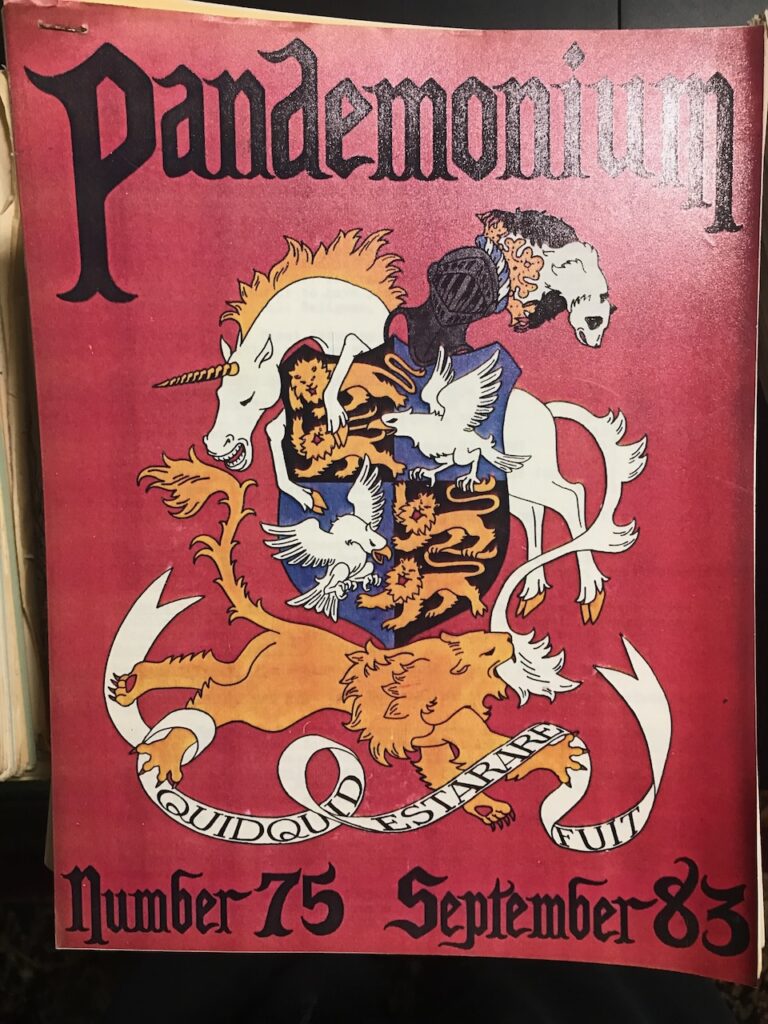
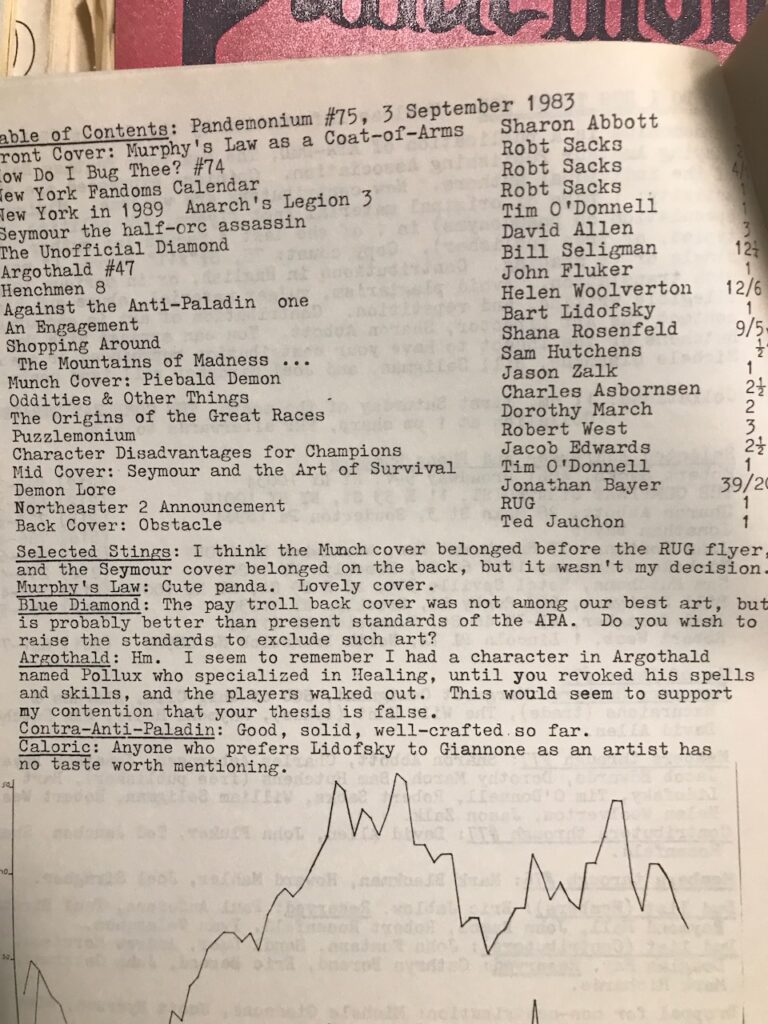

Don’t be fooled by my over-use of pictures of my own covers. The majority of Pan’s covers came from people trying to do something artistic. Some of them (Margaret Gemignani, Lori Walls, and Gennie Summers come to mind) went “pro”.
Not with a bang…
The beginning of the end of Pan was initiated by The Compleat Strategist. The gamers who were using that back room did not represent a significant amount of business for them. Also, they needed the back room for permanent organization and storage; they may have been shoving boxes aside to make room for gamers every weekend, but they could no longer do so. They informed Robert Sacks we could no longer use the space.
By that time (1985 or 1986, maybe?) the major fannish wounds between Robert and I had healed. At the time, I was still living in my father’s house in Brooklyn. My father took a dim view of my gaming activities (as he had since I first started playing D&D in 1975), but he let me invite friends over for activities. The location of collations was shifted to my home. For anyone used to the NYC subway system, taking a train into Manhattan or into Brooklyn was equally convenient.
My father’s dining-room table was not as large as the table at the Strategist, but over time that became less of a problem as the number of contributions shrank. At the Strategist, someone could walk by and ask what we were doing. That couldn’t happen at my house. If we lost a contributor for some reason (e.g., they went pro), we weren’t likely to gain a new one.
Finally, the hammer fell. In 1987, I informed Robert that I was going to Fermilab (near Chicago) for a year to do my physics Ph.D. research. My father had made it clear that, when I got back, it would be to a place of my own. (He was not being cruel. I was in my mid-20s. It was past time to leave the nest.) Pan would have to find a new place for collations.

I returned from Fermilab in March 1988. By that time, Pan had fallen on hard times. Robert collated the issues where he could, including his apartment. I had moved to Rockland County (into the same apartment in which I type these words). It was impractical for anyone in NYC to commute there.
There was another factor that must have occurred to you if you’ve gotten this far in the post: The Internet was beginning to move into people’s living rooms. APAs were competing with Compuserve, Usenet, and bulletin-board systems. The sound of the dial-up internet modem was a death knell for the APAs.
Contributions had dried up. Robert pulled the plug.

Mentat
Let’s move on to a different APA in my trunk: Mentat.
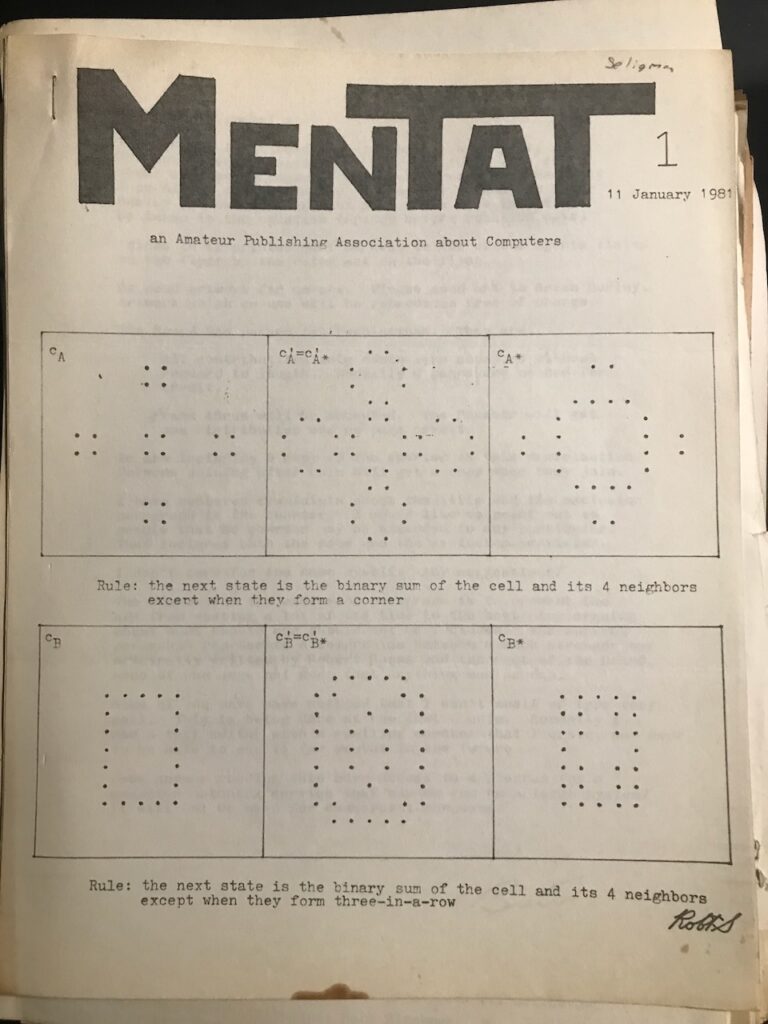
Pandemonium was an APA about fantasy role-playing games. I started Mentat to be an APA about computers.
Edit added over a year later: When I reviewed my copies of Mentat after they were scanned (see the end of this post), I was surprised to discover that I was not the one who started Mentat. I only became its Manager later on. My addled memory insists that I was the one who came up with the name “Mentat” but I can’t be sure. The original first Manager of Mentat was Brian Burley.
Given my “death knell” paragraph above, it may seem silly to have started up an amateur publication about computers and computing. However, look at the date on the cover of issue 1: 1981. At the time, home-based Internet was not generally available. However, home computing was. It seemed to me that there was enough interest in the subject to warrant a separate APA.
If I’m being honest, part of the reason I started Mentat was to show Robert “how it should be done.” Since Pan and Mentat had a different topics, different contributors, and different goals, he participated without rancor. I don’t recall any feuds in connection with Mentat, but it was also a smaller publication with a smaller circulation.


When I opened the trunk and looked at the issues, I was surprised by how many there were. If you’d asked me before I opened the trunk, I would have told you that Mentat lasted perhaps a year or so. I actually managed to publish it for seven years.
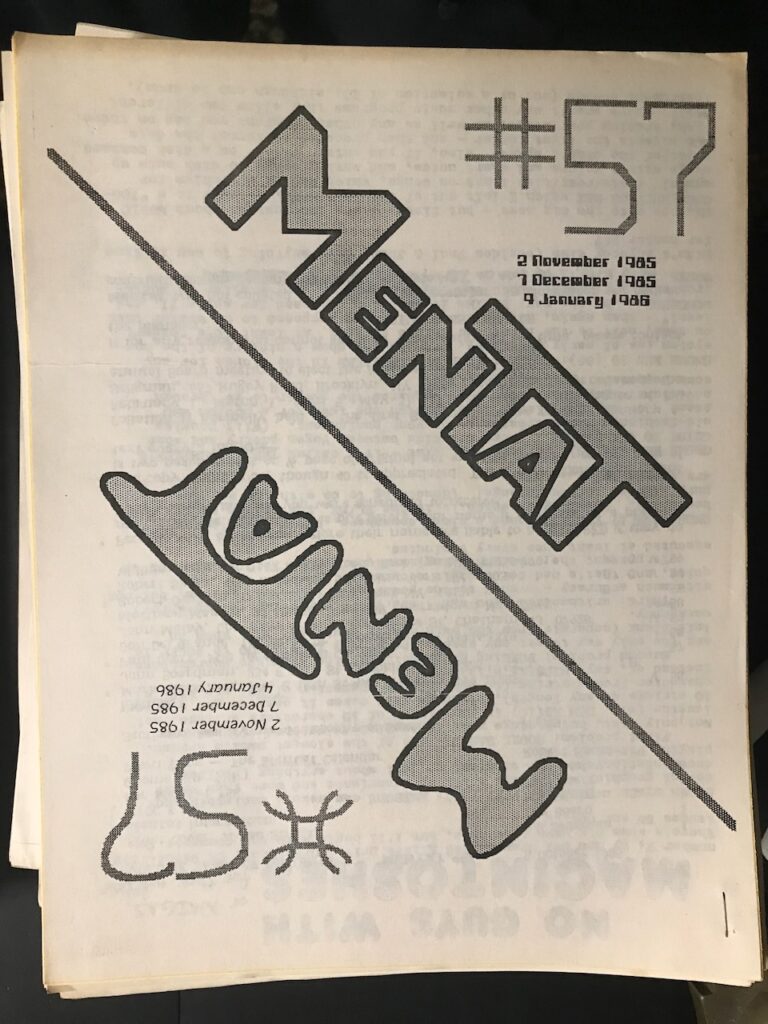
Basically, the same thing happened to Mentat as would happen to Pan a couple of years later: the Internet made it irrelevant. It happened a couple of years sooner because Mentat contributors were more likely to be on the cutting edge of communications than Pan contributors were.
The ending of Mentat was more ignominious. This is the “final issue of Mentat”:

Huh? What is this “APA-Q”?
This was a different APA. From the ToC in that issue, it appears that it was a co-production by John Boardman, Robert Sacks, and Mark Blackman. (Here I am talking about Robert Sacks, when John Boardman was a much bigger figure in the history of NY-area gaming and Mark Blackman barely less so; someone write their histories!) My fragmented memory suggests that many issues of Mentat were collated at John Boardman’s home, probably at his popular “First Saturday” parties.
We agreed to merge Mentat with APA-Q. The only difference that the merge ever made to APA-Q was the back cover of issue 331, along with a next-to-the-last page announcing the merger:
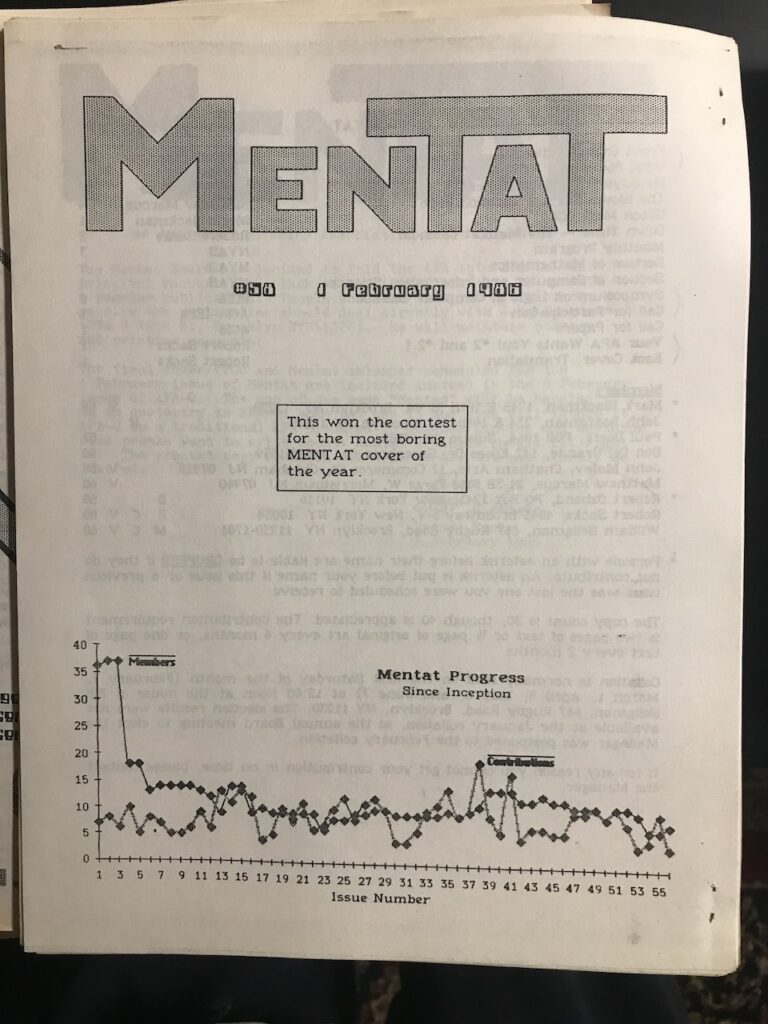
So it goes.
unRealities
I’ve told the story of unRealities before in this blog. But to spare you having to click a link:
unRealities was bimonthly APA that I started myself after I came back from doing my thesis experiment in Chicago. This APA contained articles on fantasy role-playing, written by friends in NY, friends I had made in Chicago, and others; my mother even contributed an article or two.
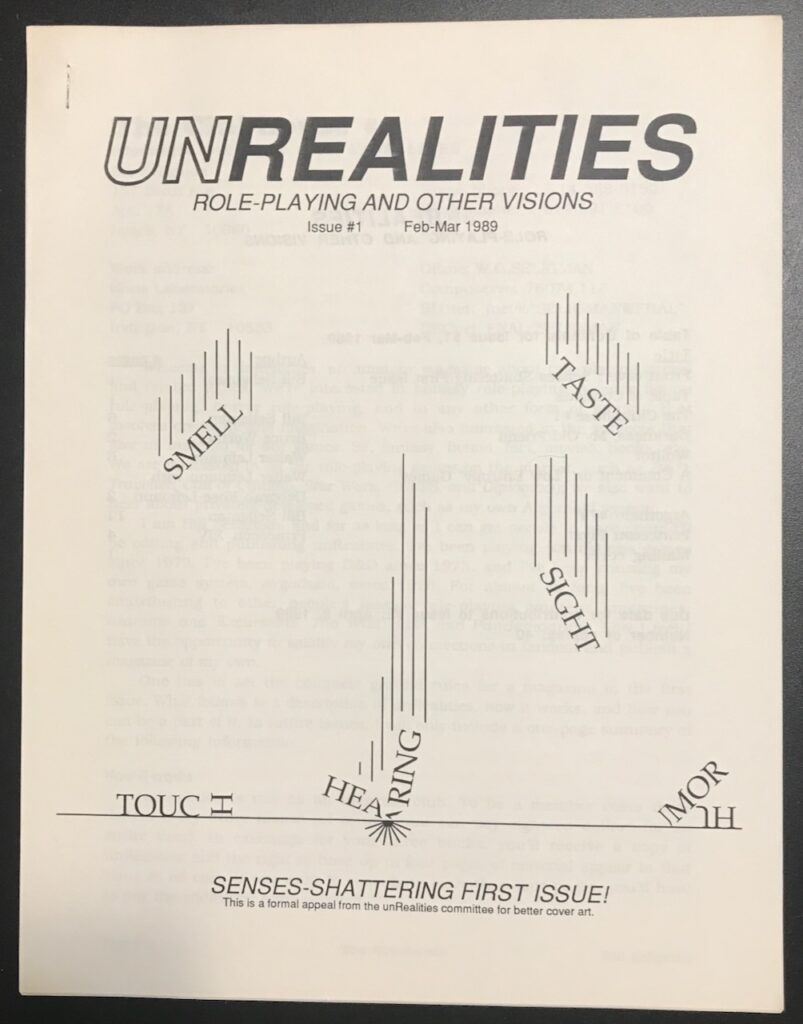
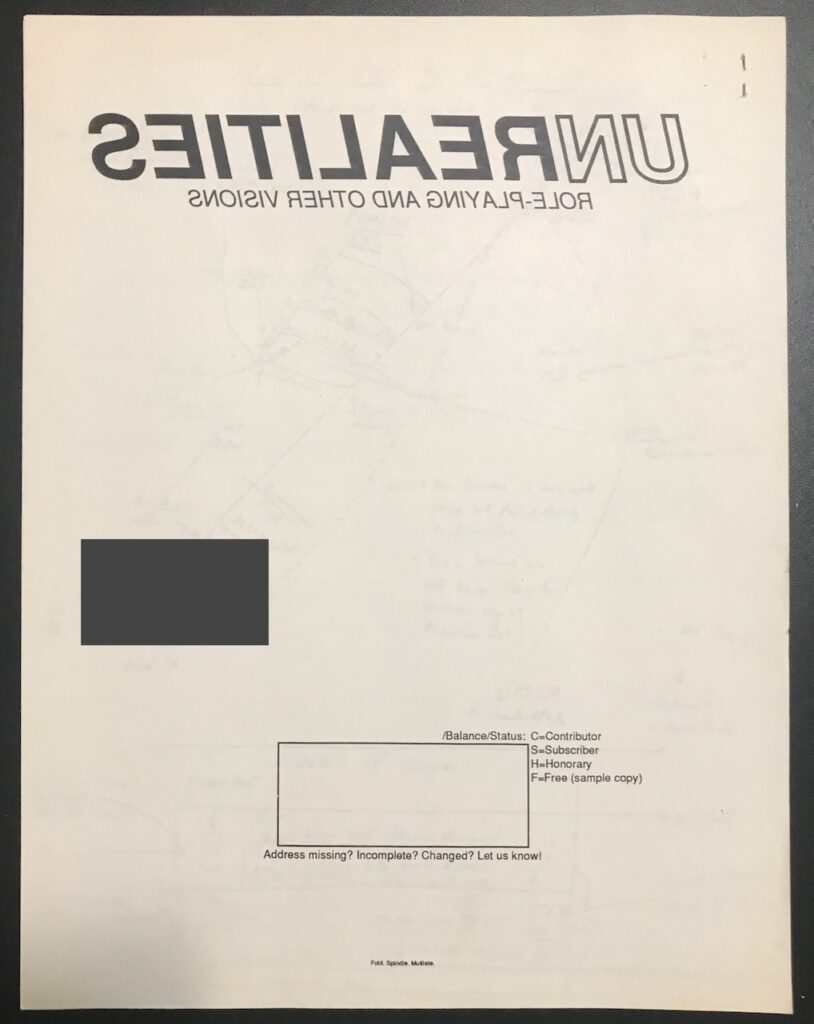
What made unRealities different from Pandemonium and Mentat is that it was presented in the form of an “edited journal.” I retyped the articles (those which I did not myself write) into Microsoft Word to give a uniform appearance to its contents.
Some of the contributors were not happy with this approach. If you were to look inside the older APAs in the trunk, you’d find page after page typed in single space, with narrow margins, and few paragraphs; I wanted to get away from that visual confusion. No unRealities contributor ever gave me anything that bad, but some asked that I not retype their articles.
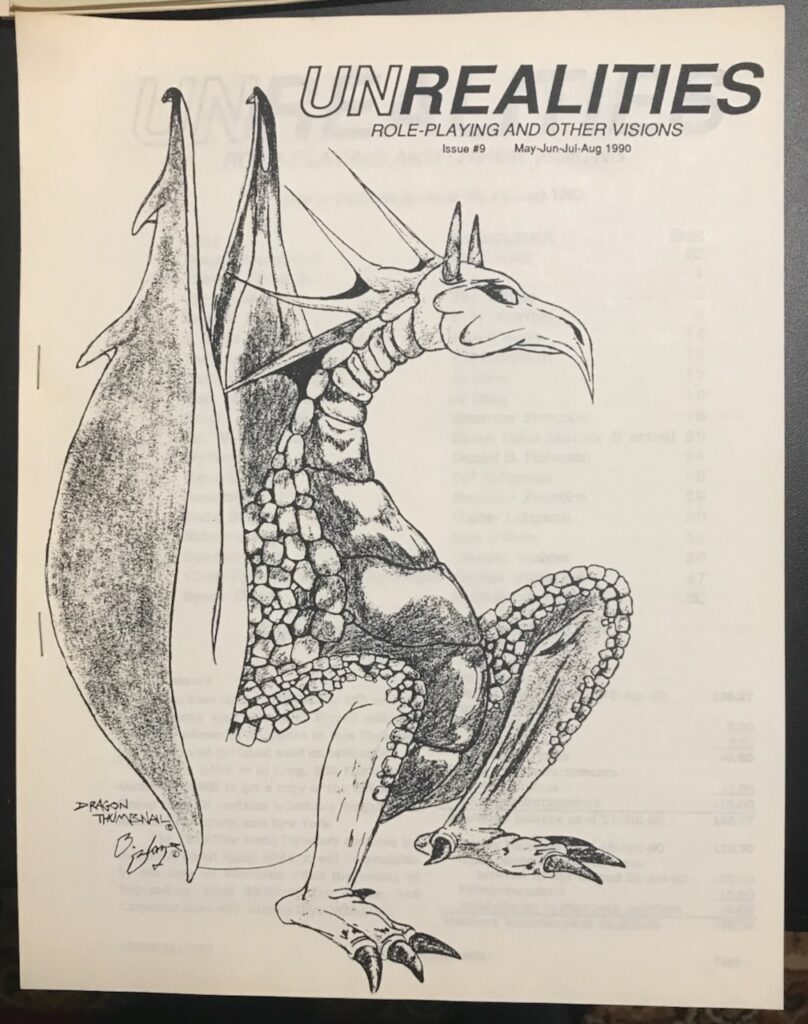
Issue 9 was, in my opinion, the best issue of unRealities, in the same sense that Pan 75 was the best issue of Pandemonium. It included a couple of stories by me, and even some artwork from my mother.
I published unRealities for twelve issues before a combination of becoming too busy for APAs and a lack of contributions called a halt to the project.
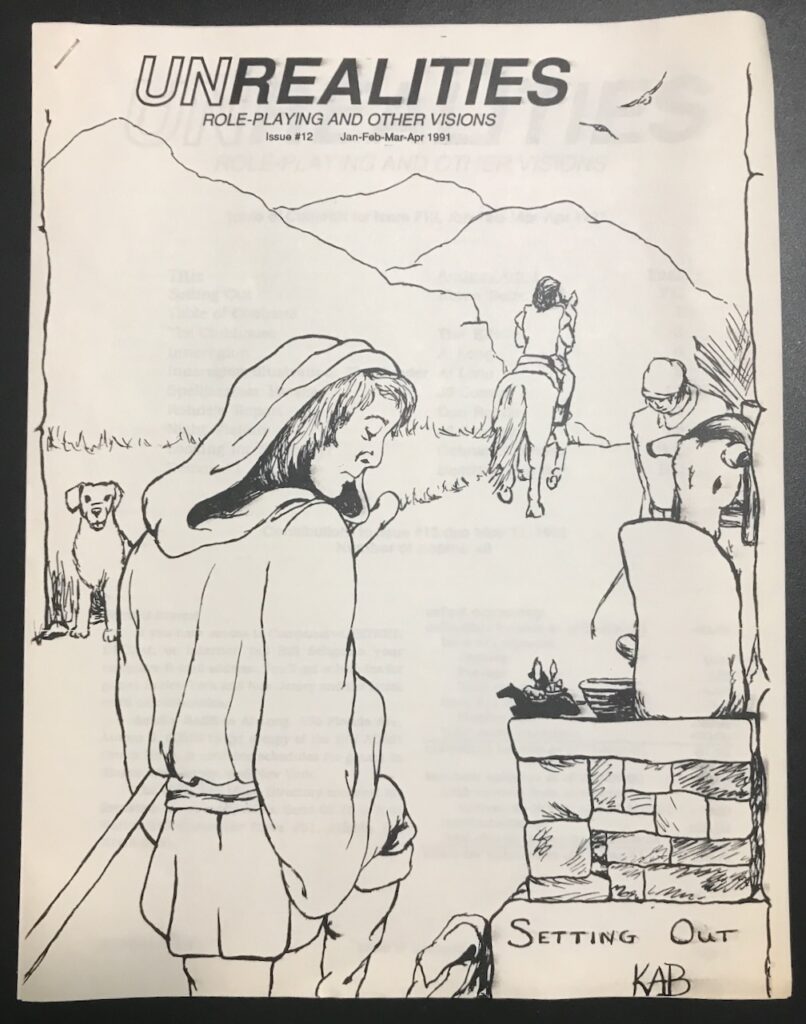
The strange thing about unRealities that I completely forgot that I published it. 15 years after I published the final issue, I discovered a pile of the APAs and remembered that it existed. In the 14 years since, I haven’t forgotten it again. That’s something, I suppose.
The New York Feud
There was more in the trunk than the APAs to which I contributed. There was this curiosity, which I’d entirely forgotten that I had:
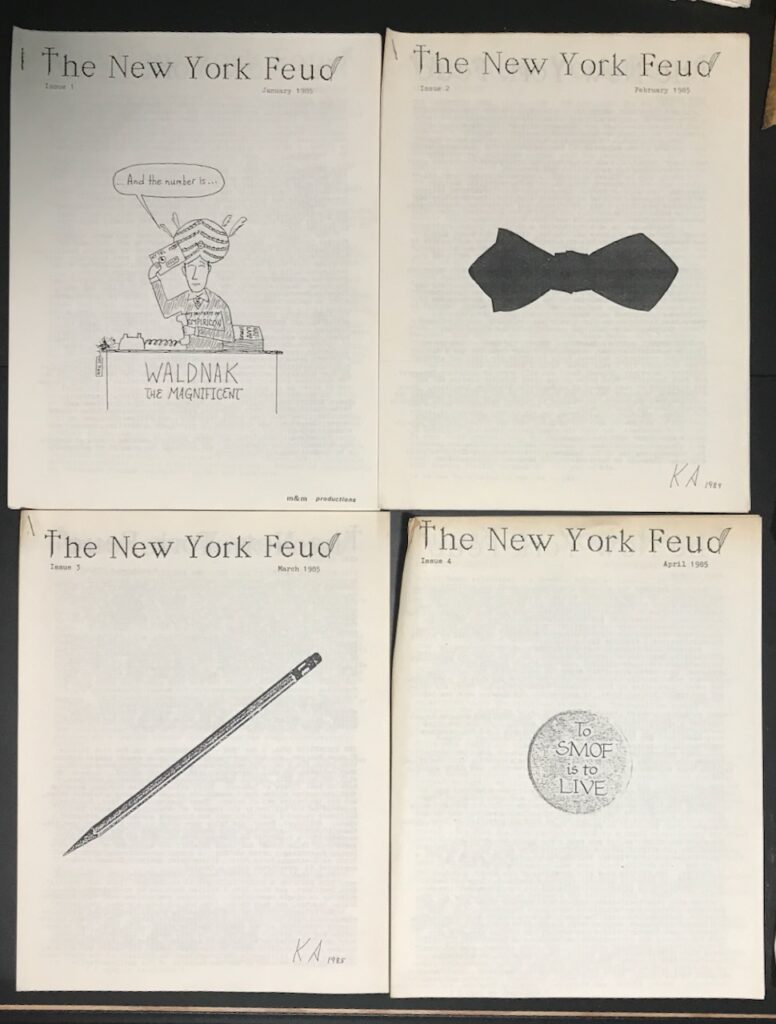
The New York Feud was apparently about (wait for it, this will be on the test) various feuds happening in NY area fandom at the time each issue was published, in the first four months of 1985.
When I looked through the issues, they mainly consisted of one insult after another directed at Robert Sacks. That made some sense; the bow-tie on the cover of the second issue gave that away.
Then I looked at the writer and publisher of NYF: It was Robert Sacks.
The one non-Sacks contributor turns out to have been me, in issue 2. Again, this is something I’d utterly forgotten. The title of the contribution was “Why Can’t People Get Together and Learn to Live in Peace and Harmony? #1.” I asked the question of why NY-area fandom has consistently failed to get a Worldcon bid together. It’s been four decades since I wrote the article, and there still has been no Worldcon in NY.
(Comic Con does not count. Comic Con is run by media companies. Worldcon is organized and run by fans. I know Comic Cons are fun and people pour their hearts and souls into making it work, but if you’ve ever been to a fan-run convention, you know there’s a difference. Whether that difference is positive or negative I leave to you.)
I must have worked with Robert on this brief APA, since he credits me with designing the logo for him. Again, I have no memory of that at all.
What does “To SMOF is to LIVE” mean? SMOF is fanspeak for “Secret Master of Fandom.” It basically refers boasting of one’s various activities in the fan community and how the sum of those activities makes you, well, a SMOF.
This entire post may be interpreted as SMOFing on my part. If so, I apologize.
Fire the Arquebusiers!
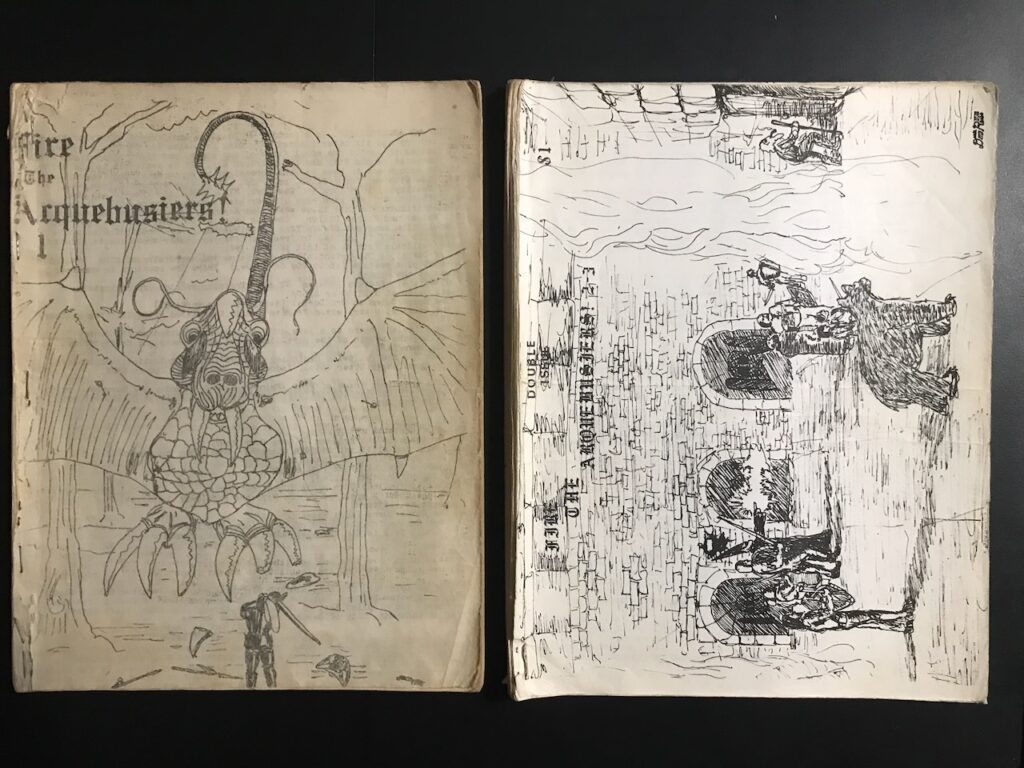
This was an APA published by Greg Costikyan in 1975. There may been more issues than just these two. I kept these because I liked Greg’s articles, and they gave me some initial insight into NY fandom.
I have no idea how I got them. Issue 2-3 (the double issue) was mailed to me, so I must have subscribed. I have a memory fragment that suggests I visited Greg’s apartment once as part of some game; he might have handed issue 1 to me then.
Oracle

Another amateur magazine that I forgot I had.
When I looked through it, I saw that it had been published by Adventurer’s Unlimited. This was a Ren-Faire fan group to which I belonged in the early 1990s. I saved that issue because it was the one that announced the death of Michael “Doc” Brennan. I wrote about AU and Doc in one of my Ren Faire blog posts.
To put it simply: Doc was a friend to me at a time in my life when I probably did not deserve one. It’s been three decades since he died. I still miss him.
Beyond APAs
There were a few publications in the trunk that were not APAs.
The Dungeoneer
If an “APA” is one form of amateur magazine, a “prozine” is a magazine that’s professionally published. The Dungeoneer was a prozine, even though its first issues look a bit amateurish by today’s standards.
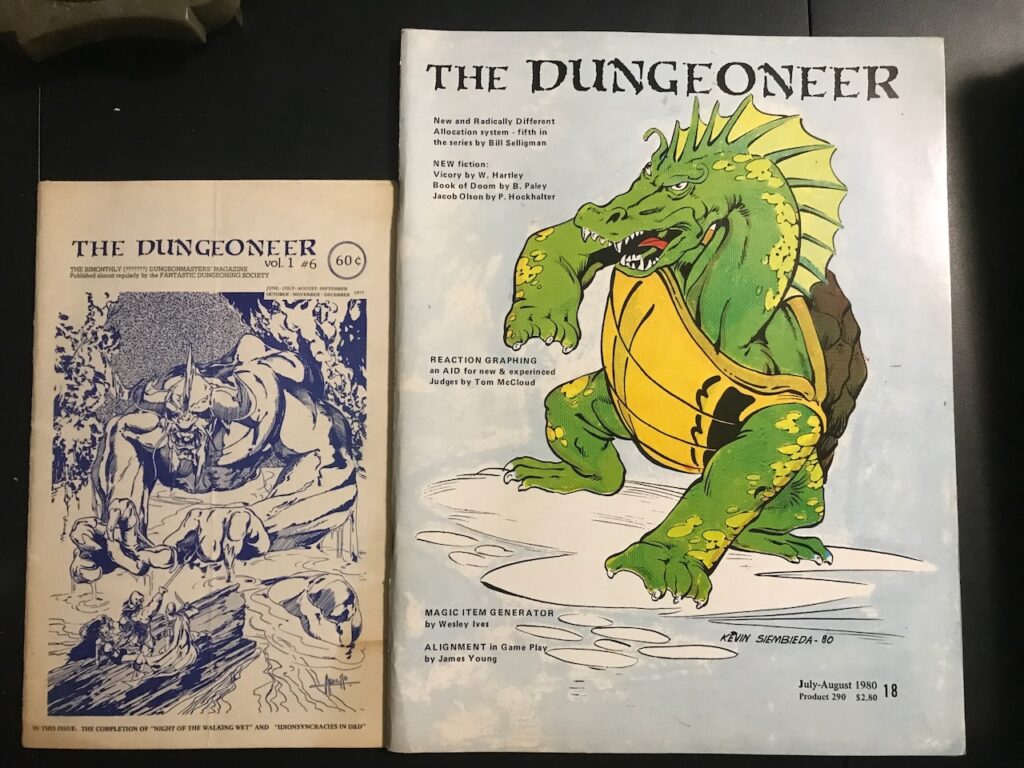
The reason I saved issues of The Dungeoneer was they contained a series of articles I wrote on the Argothald system as it existed at the time. Those articles are not worth seeking out. I struggled for decades to create an RPG system that suited me, only to recognize the truth: I’m not a game designer. Eventually I settled on Fate Core.
There’s one particular issue in the trunk of personal importance to me:

This is the issue in which my article on Argothald’s magic system appeared. It attracted the attention of Isaac Bonewits. He wrote to me about the article, and I answered. That was in 1978. In 1991 I met him in person at my first Wicca class. I took the opportunity to apologize again.
Why apologize? Take a look at the first two pages of the article. I’ve blurred sections for a reason that will be obvious to anyone who’s read Isaac’s book Real Magic.

Even though I credit Isaac in the article, this was plagiarism. Bill of 2023 was astonished at what Bill of 1978 had done. This goes far beyond “quotes for review purposes” or whatever is allowed under the copyright laws.
At the time, I thought that this “Bonewits” guy could not possibly know about fantasy role-playing games. To me, it seemed as harmless as quoting liberally from a physics textbook in an article on dragon anatomy.
What I did not know is that Isaac was well aware of RPGs. He was participating in game sessions with such well-known game designers as Greg Stafford and Dave Hargrave. (They may not be well-known now, but they were household names in 1978, at least if your household played RPGs.) He had published Authentic Thaumaturgy, an adaptation of Real Magic to an RPG setting.
Whether Isaac was aware of RPGs or not, my liberally quoting him in this way (even with attribution) was simply a wrong thing to do.
Fortunately for me, Isaac took the whole thing calmly and with a friendly attitude. He wrote me to say that my system seemed playable. He did not hint that I had plagiarized his work.
In fact, in the second printing of AT from Chaosium (not to be confused with the second edition, which was published by Steve Jackson Games), he included my idea that “Infra-Red Magic” could refer to Undead creatures, and credited me for it.
I miss Isaac too.
A hymnal and a musical
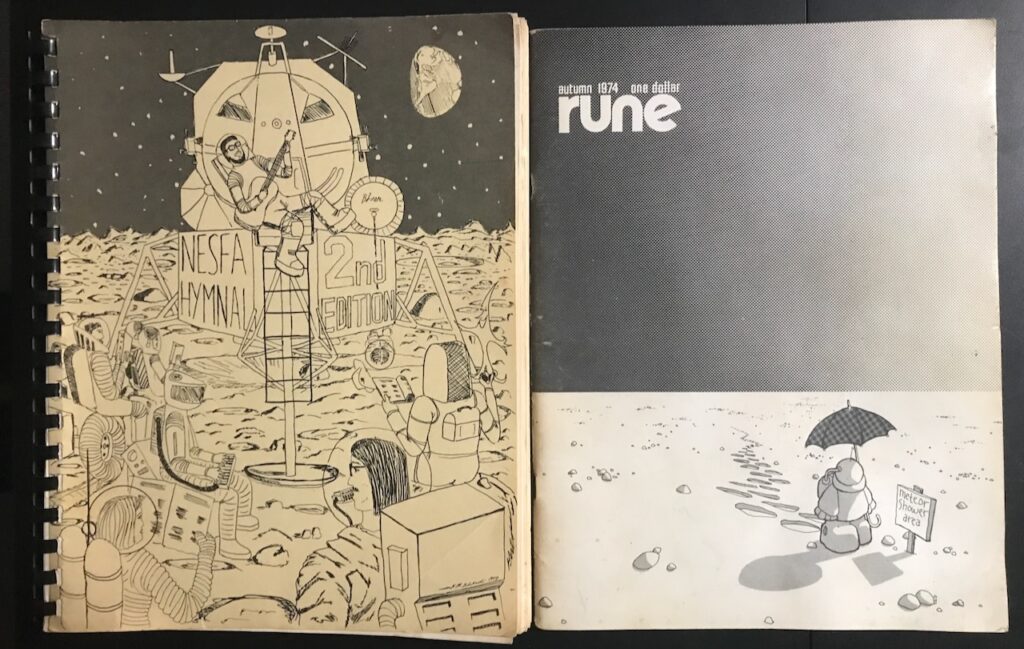
Also in the trunk:
- A filksong is a piece of music related to science fiction, fantasy, and other genre topics. The NESFA Hymnal is a large collection of filksongs published in 1978 by the New England Science Fiction Association. By now the book is “obsolete,” in the sense that many more worthy songs have been written since then. Also, some of the works being parodied have faded from the memories of SF fans. I kept it because, although I can’t sing, I don’t let that stop me. It takes very little prodding to get me to warble “Home on Lagrange.”
- Rune autumn 1974 was published by a group at Ohio State University. I kept it because it contains the complete libretto of HMS Trekastar, a Gilbert-and-Sullivan Star Trek parody.
What’s next?
Now that I’ve emptied the trunk, what do I do with all of this?
I could just stuff it all in the trunk again, and go through another round of reminiscence in a couple of decades. However, H. Tucker Cobey’s query reminded me that there are researchers out there who’d be interested in this material.
Fortunately, one of my friends is a librarian. She has offered to scan all those APAs into PDF files. There are thousands of pages (double-sided of course), but she has access to a good-quality scanner.
This is going to be a “destructive scan,” in that I’ve told her that she can remove the staples before dumping the issues into the hopper of her scanner. After that, it’s probably not worth restapling the issues again, especially since some of them are falling apart as it is. The physical copies will… uh… go to a farm where they can play with other APAs, but where we’re not allowed to visit.
Once I have the files, what then? I’m not going to just hand them out. This is partly because much of what’s in there is personally embarrassing.
However, the main reason is that contributors to APAs included a large amount of personal information that, even four decades later, could still compromise their security. In those days, publishing your address and telephone number in an amateur magazine with a circulation of 40 meant nothing. These days it would leave one open to doxxing. While it’s likely that few of them still have the same address, this information is used as security checks for credit reports and such.
My plan is to find a library that maintains a digital collection that has appropriate rules for handling such potentially sensitive material. If my friend’s library does not work with digital collections, my next stop will be the Columbia University Digital Humanities Center. I’ve visited them some years ago. I know they have policies in place to protect the privacy of people in their archives.
Of course, they may not be interested in my old APAs. We’ll see!
Edit, added a couple of years later: If you’d like to see scans of the APAs I describe above, see this page.

Pingback: Theory review #174 – ropeblogi
Pingback: The Roleplaying APAs: 1975-Present – Designers & Dragons
Hi – not sure where these materials landed vis-a-vis libraries, but I work in one (actually one of the mentioned libraries) and might be able to steer an inquiry. I landed here trying to find a way to access Fire the Arquebusiers – I imagine there are other folks in the same boat!
By coincidence, Fire the Arquebusiers is going to be among the next (and last) APAs in my collection to be scanned!
If you’re interested, you can reach me at “name of this blog” (the word before the .com) at gmail dot com. Let me know which library you work at it.
We’ll figure out a way to get these a home!
Pingback: APA Scans – The Argothald Journal